Planting shade-loving edibles along your fence maximizes garden space while creating a productive privacy screen. You’ll enjoy leafy greens, climbing berries, and herbs that thrive in partial shade conditions. These plantings require less maintenance and water than sun-exposed gardens, while improving biodiversity and soil health in your yard. Fence-line edibles also create natural gathering spaces and can provide year-round harvests with proper planning. Discover how this dual-purpose approach transforms ordinary boundaries into food-producing assets.
Maximizing Urban Garden Space With Fence Plantings
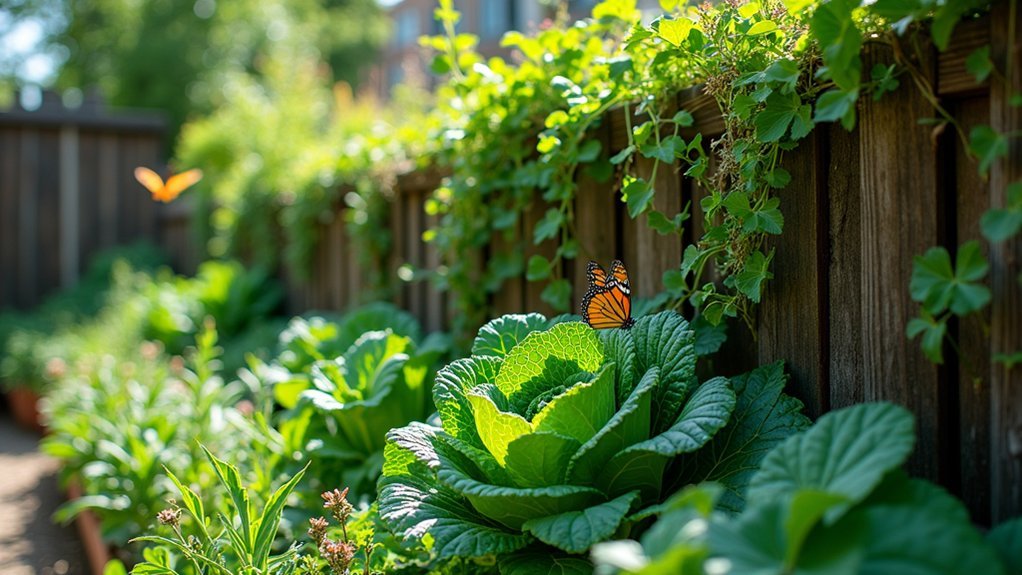
While traditional garden beds consume valuable square footage in cramped urban settings, vertical fence plantings offer a practical solution for space-challenged gardeners. By utilizing your existing fences, you’re fundamentally creating a second garden that doesn’t take up any ground space.
Attach planters or repurposed gutters to your fence to grow shade-loving edibles without expanding your footprint. Metal mesh or wire frames can support climbing vines that double as privacy screens while producing food. Consider installing plastic mesh netting to protect your plants from squirrels and other wildlife that might target your produce.
Transform ordinary boundaries into productive living walls with creatively mounted planters and climbing supports.
These living walls not only enhance your garden’s aesthetic appeal but also improve biodiversity and air quality in your urban environment.
For maximum efficiency, consider integrating different planting methods—hang lightweight containers for herbs, install trellises for climbers, and mount deeper planters for root vegetables—turning ordinary boundaries into productive gardening assets.
Top Shade-Tolerant Edibles for Vertical Gardens
Now that you’ve established your vertical growing space, you’ll need to select plants that can actually thrive in shadier conditions. Numerous edibles flourish in less-than-full sun, making them perfect for fence gardens that might be partially shaded during parts of the day. Understanding the different light conditions, from dappled shade to full shade, will help you match plants to your specific garden environment.
| Plant Type | Examples | Benefits |
|---|---|---|
| Leafy Greens | Lettuce, Nasturtiums | Peppery flavors, prevents wilting in heat |
| Climbing Berries | Blackberry, Currants, Gooseberries | Excellent for trellises, productive in partial shade |
| Herbs | Chives, Valerian, Ginger | Versatile culinary uses, medicinal properties |
| Fruit Options | Cherry, Elderberry, Goumi | Attracts beneficial insects, jam production |
| Ground Covers | Sweet Violets, Chilean Wintergreen | Edible flowers, berries, maximize space usage |
Choose plants based on your specific shade conditions and vertical structure for best results.
Creating Privacy Screens With Edible Climbing Plants
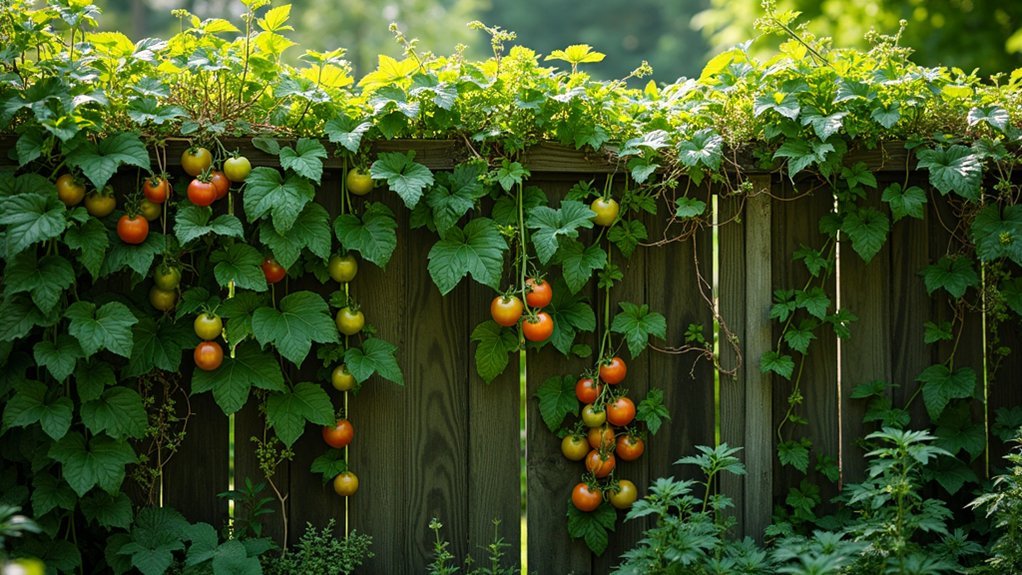
Creating a natural privacy screen that doubles as a food source represents one of the most rewarding uses of edible climbing plants. You’ll enjoy both seclusion and sustenance by strategically planting varieties like pole beans, climbing peaches, and kiwi vines along your fences or trellises.
These versatile plants create year-round structure while offering seasonal visual interest through changing foliage, flowers, and fruits. Many options, including grapes and passionfruits, produce vibrant blooms before yielding their edible rewards. Passionfruits are particularly effective with their thick, lush leaves that are ideal for covering fences or creating screens.
Beyond privacy and food production, your living screen will attract beneficial insects, stabilize soil, and support local biodiversity. The dense foliage can even create favorable microclimates in your garden space.
With minimal gardening experience, you can easily train these plants to transform bare boundaries into productive, beautiful barriers.
Year-Round Harvests From North-Facing Fences
You can maintain continuous harvests using north-facing fences by employing strategic seasonal planting rotations.
Start with cold-hardy crops like spinach and arugula in early spring, then shift to gooseberries and currants for summer, and finish with leafy greens again in fall.
Your north-facing microclimate will protect plants from excessive summer heat while extending your growing season by weeks on both ends of the year. For areas with deeper shade, consider planting decorative and edible shade-tolerant hostas, which thrive in USDA zones 3-9 and provide attractive foliage alongside edible shoots.
Seasonal Planting Strategies
While north-facing fences typically receive less direct sunlight throughout the year, they can still become productive growing spaces with strategic seasonal planning.
By rotating crops seasonally and preparing soil properly, you’ll maximize your harvest potential in these challenging conditions.
Your north-facing fence planting strategy should include:
- Early spring planting of shade-tolerant bulbs like snowdrops and crocuses for beauty before leafy edibles take over
- Summer cultivation of climbing edibles such as certain varieties of beans that can thrive with 4-6 hours of indirect light
- Fall addition of nutrient-rich mulch to retain moisture and regulate soil temperature
- Winter protection systems using climbing frames that can double as supports for early spring seedlings
In Eureka’s Zone 9b climate, you can successfully grow persimmon trees along your fence, as they’ll receive adequate south facing sun once they reach sufficient height.
Remember that proper drainage is essential in shaded areas to prevent fungal issues that thrive in moist conditions.
Cold-Hardy Fence Crops
North-facing fences transform into productive growing spaces when planted with cold-hardy edibles that thrive in shadier conditions.
These areas create unique microclimates that retain moisture and protect plants from harsh winds while reducing evaporation.
American hazelnuts, hardy figs, and rhubarb excel in these cooler zones, requiring minimal maintenance while improving soil health.
For security with sustenance, consider thorny blackberries or trellised grapes that form protective barriers while producing food.
Red and black currants, gooseberries, and cold-hardy kiwi varieties adapt well to partial shade along north-facing boundaries.
Even elderberry and Arctic bramble offer reliable harvests in these conditions, with elderberry shrubs growing up to 10-30 feet tall while providing both privacy and delicious berries for various culinary uses.
Combining Beauty and Function With Ornamental Edibles
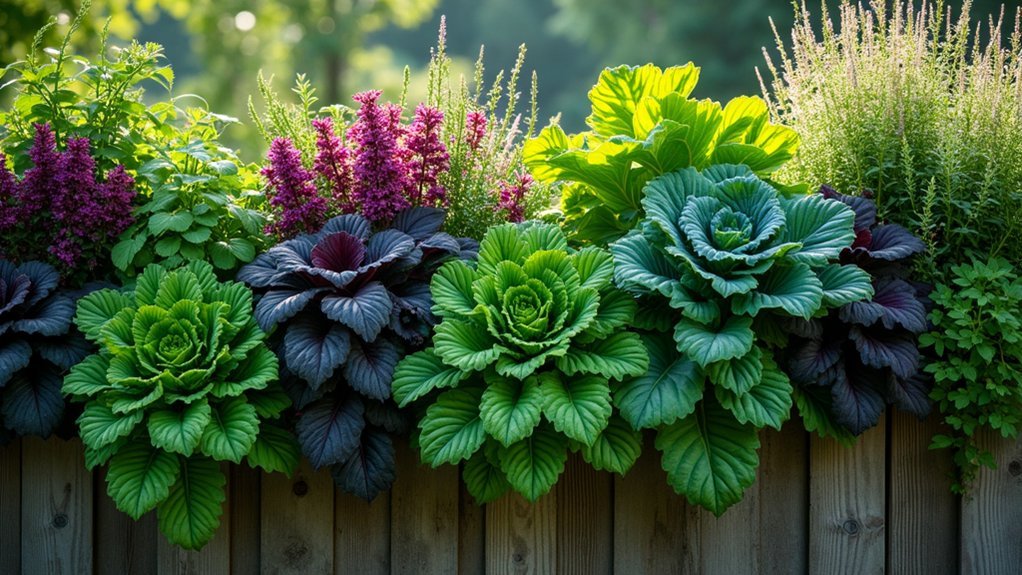
Beyond their practical value, ornamental edibles transform ordinary landscapes into vibrant, multi-purpose gardens that delight all the senses.
You’ll create visually stunning spaces while enjoying fresh harvests right from your fence line.
By integrating these dual-purpose plants, you’re not just growing food—you’re designing a landscape that changes with the seasons, offering continuous visual interest from spring blooms to fall foliage. These plants typically need a minimum of 6 hours of direct sunlight to thrive and produce well.
- Shrubs like black aronia provide structure while delivering flowers, berries, and autumn color
- Fragrant herbs such as rosemary and chives offer edible flowers alongside their culinary uses
- Decorative containers can showcase strawberries and other small edibles while enhancing aesthetics
- Strategic plantings attract beneficial insects and pollinators, improving your garden’s overall health
Water Conservation Benefits of Shade-Loving Plants
Growing shade-loving edibles offers significant water conservation advantages through naturally reduced evaporation rates.
Your partial-shade garden maintains higher soil moisture levels, creating microclimates that retain humidity and require less frequent watering. Mature trees provide excellent cover for shade-loving edibles, reducing water needs while offering varying levels of protection depending on their size.
Reduced Evaporation Rates
While many gardeners focus on finding sufficient sunlight for their edibles, shade gardens offer a considerable but often overlooked water conservation advantage. The shade created by your fence and shade-tolerant plants dramatically reduces evaporation rates, helping you conserve precious water resources.
When you plant along your fence line, you’ll benefit from:
- Lower soil and air temperatures that naturally decrease water loss
- Stable moisture levels that reduce plant stress and watering frequency
- Microclimates created by dense foliage that retain humidity
- Improved soil structure that enhances water retention capacity
This natural water efficiency means you’ll spend less time watering and more time enjoying your harvest. Consider incorporating herbs like sweet bay and rosemary that require minimal water while adding delicious flavors to your cooking.
Your shade-loving edibles will thrive with consistent moisture levels, while requiring considerably less irrigation than their sun-loving counterparts.
Moisture Retention Strategies
Shade-loving edibles offer sophisticated moisture retention capabilities that extend far beyond simple water conservation. By planting large-leafed varieties like collards and chard along your fence, you’ll create a natural mulching effect that blocks sunlight and prevents soil exposure.
These plants work together to transform your fence line into a moisture-preserving ecosystem. Their dense foliage prevents wind from stripping surface moisture, while their decaying matter builds a water-retentive humus layer. This natural process means you’ll need to water less frequently as shady areas retain moisture longer than sun-exposed sections.
You’ll notice improved soil structure as taproots break up compaction and create capillary channels for water movement. The microclimate these plants establish mimics woodland understory conditions, with leaf transpiration increasing humidity and reducing thermal stress.
For maximum benefit, create multi-layered plantings that replicate natural water catchment systems, with taller plants protecting moisture-sensitive crops beneath them.
Lower Irrigation Needs
Unlike their sun-loving counterparts, edibles thriving in shade dramatically reduce your garden’s water demands through natural conservation mechanisms.
Shade creates a microclimate that preserves soil moisture and supports healthier plant physiology, meaning you’ll spend less time with the hose.
Your shade-loving plants benefit from:
- Reduced evapotranspiration rates, preserving moisture that would otherwise evaporate quickly
- Cooler soil temperatures that maintain microbial activity and improve water retention
- More efficient photosynthesis under partial shade conditions, requiring less water for growth
- Natural protection from heat stress, eliminating the need for emergency watering during hot spells
Plants like Miners Lettuce prefer partial shade environments and require significantly less irrigation than full-sun varieties, making them ideal water-wise choices for biodiversity gardens.
Designing Multi-Layered Edible Fence Gardens
Transforming an ordinary fence into a productive edible garden requires thoughtful vertical planning and spatial awareness.
Think in three dimensions by training climbing edibles like kiwi and grapes on trellises while installing vertical herb planters on fence surfaces.
Embrace vertical potential—transform fence planes into living walls of kiwi vines, grape canopies, and cascading herb gardens.
Position dwarf fruit trees 3-4 feet from fence lines, then fill intermediate spaces with mid-height shrubs. Hang strawberry baskets along fence tops and interplant quick-growing greens between perennials for continuous harvests.
Exploit microclimates by using north-facing sections for cool-season crops and fence-backed beds for heat-loving plants like peppers. Incorporating edibles with ornamentals creates a healthier ecosystem while maintaining visual appeal.
Create aesthetic appeal by alternating color-coordinated vegetables in patterns and incorporating ornamental edibles as focal points.
Build fence-adjacent raised beds for root vegetables or attach hinged planter boxes to posts for modular options that maximize both productivity and visual interest.
Pest Management Through Strategic Fence Planting
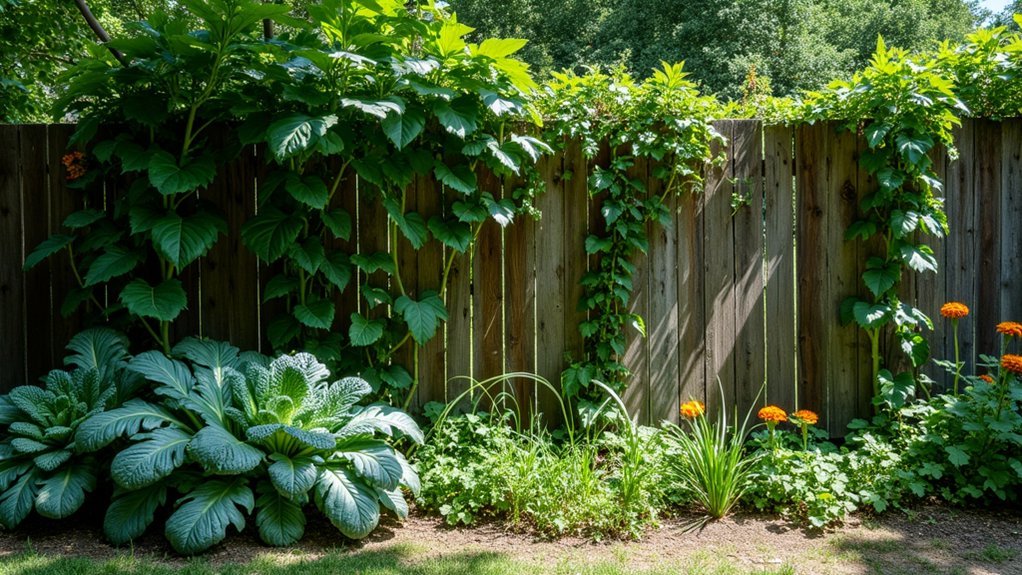
Strategic fence planting serves as your first line of defense against garden pests while maximizing productivity in shaded areas.
By thoughtfully arranging companion plants along your fence, you’ll create a balanced ecosystem that naturally manages pest populations.
Consider these pest management strategies for your fence garden:
- Plant trap crops like nasturtium or chervil to lure pests away from your primary edibles.
- Incorporate aromatic herbs such as mint, lemon balm, and catnip to repel unwanted insects while attracting beneficials.
- Use containers for invasive pest-repellent plants like mint to prevent them from overtaking your garden.
- Layer plants strategically, placing taller pest-deterrent species like spicebush behind shorter edibles for extensive protection.
You’ll find that a diverse fence planting not only provides edibles but creates a resilient system requiring fewer interventions. Planting marigolds along fence lines will help deter nematodes while adding vibrant color to your edible landscape.
Transforming Chain-Link Fences Into Food Sources
Chain-link fences offer untapped potential as vertical growing spaces for shade-tolerant edibles. You can transform these utilitarian structures into productive food sources by selecting appropriate climbing plants like blackberries, raspberries, and certain grape varieties that tolerate partial shade.
Your fence naturally serves as a trellis, eliminating the need for additional supports while expanding your growing area without consuming precious ground space. Plants like beans and climbing cucumbers will happily wind their way up the metal links, creating a living wall that’s both beautiful and bountiful.
Transform your ordinary boundary into extraordinary harvest space as climbing plants embrace your fence’s ready-made support system.
This approach offers multiple benefits: increased garden productivity, improved aesthetics, and year-round visual interest. Growing plants on your fence provides privacy while producing food at the same time.
While you’ll need to take into account watering needs and occasional reinforcement for heavily-bearing plants, the maintenance is generally less demanding than with other growing methods.
Soil Preparation for Fence-Line Garden Success

Fence-line soil often needs significant improvement before planting, so you’ll want to thoroughly test and amend it with organic matter to address common issues like compaction and poor drainage.
Double digging along your fence can dramatically improve root penetration and aeration, while incorporating amendments like compost and sand creates the ideal growing environment for shade-tolerant edibles.
You’ll need to address drainage challenges by creating slight mounds or raised beds, which prevents waterlogging in these typically shadier, less-ventilated areas. Incorporating decorative elements like garden edging or stone borders can help define your planting areas while adding structure to your fence-line garden.
Enriching Fence-Side Soil
When preparing a garden along your fence, you’ll often face soil that’s less than ideal for growing plants.
Fence lines typically suffer from compaction due to foot traffic and installation work, creating challenging growing conditions for your edibles.
To transform this difficult soil into a fertile growing medium:
- Aerate compacted areas through double digging or tilling to improve drainage and root penetration
- Add quality compost to increase organic matter content and boost nutrient availability
- Apply 2-3 inches of mulch to retain moisture and gradually improve soil structure
- Consider sheet mulching for low-effort soil improvement over time
Test your soil to understand its specific needs before adding amendments.
Clay soils benefit from extra organic matter, while sandy soils need materials that help retain moisture and nutrients.
Smart Drainage Solutions
Even shade-loving edibles require proper drainage to thrive, especially in the challenging conditions along fence lines where water often pools or runs off too quickly.
Create a balanced system by amending soil with organic matter and incorporating gravel layers at 6-12 inch depths for subsurface movement.
Install French drains wrapped in landscape fabric to prevent clogging, and grade trenches at a 1% slope for ideal flow.
Percolation tests will identify slow-draining zones needing intervention. For sloped areas, consider swales with check dams to control erosion.
Maintenance matters—flush pipes annually, inspect fabric barriers every two seasons, and clear debris before heavy rainfall.
Integrate your drainage solutions with landscaping by disguising outlets with ornamental grasses or creating rain gardens using water-tolerant edibles downstream of drains.
Seasonal Rotation Strategies for Fence Gardens
Strategically rotating crops along garden fences transforms these boundaries into dynamic growing spaces that adapt to changing seasonal conditions.
By following smart rotation principles, you’ll maximize harvests while maintaining soil health throughout the year.
- Follow nitrogen-fixing legumes with heavy feeders like tomatoes near sun-drenched fence sections to utilize residual nutrients.
- Adjust fence panels seasonally—taller configurations for summer shade, removed in winter for maximum sunlight penetration.
- Plant quick crops like radishes and arugula between main plantings to guarantee continuous yields from fence areas.
- Leverage microclimate zones by positioning shade-tolerant edibles on north-facing sections while rotating sun-lovers through south-facing areas.
Remember to thin climbing plants in winter to increase light penetration and integrate winter cover crops to protect soil while maintaining your fence garden’s productivity year-round.
Harvesting and Pruning Techniques for Vertical Crops
Mastering proper harvesting and pruning techniques transforms vertical crops from simple plantings into consistently productive systems that reward you with abundant yields. For leafy greens, cut the entire head at the base to encourage regrowth, while herbs like mint benefit from continuous harvest methods, cutting back to the root base.
| Crop Type | Harvesting Method | Regrowth Potential |
|---|---|---|
| Leafy Greens | Cut at base | High with proper pruning |
| Herbs | Continuous picking | Excellent, becomes bushier |
| Fruiting Vines | Hand-picking when ripe | Moderate, needs regular pruning |
Regular pruning removes weak growth, prevents disease spread, and stimulates new shoots. In hydroponic or aeroponic systems, this becomes even more essential as plants can grow faster than in soil. You’ll maximize space efficiency while maintaining healthy, productive plants year-round.
Community Benefits of Edible Fence Borders
Edible fence borders transform ordinary boundary lines into vibrant community assets that nourish both people and relationships. When you cultivate these living boundaries, you’re creating spaces that bring neighbors together through shared gardening activities and harvest celebrations.
Your edible border can become a powerful community catalyst by providing:
- A natural gathering space where neighbors connect while tending plants
- Opportunities for knowledge exchange about sustainable gardening practices
- Economic benefits through shared produce that reduces household food costs
- Educational platforms for children to learn about food systems firsthand
These living fences foster community pride while improving access to fresh, nutritious food. As neighbors collaborate on maintenance, they develop stronger bonds and a greater sense of belonging, transforming individual properties into interconnected community spaces.
Frequently Asked Questions
Are Fence-Grown Edibles Safe From Neighborhood Pets and Wildlife?
No, your fence-grown edibles aren’t completely safe. You’ll need proper fencing height, buried mesh to prevent digging, and possibly electric additions to deter persistent climbers like raccoons and jumping animals.
How Do Shade-Loving Edibles Affect Fence Structural Integrity Over Time?
Shade-loving edibles can impact your fence’s integrity if not managed properly. You’ll need to prune regularly, install proper supports, and select appropriate plants to prevent excess weight and moisture damage over time.
Can These Edibles Grow Successfully in Container Gardens Along Fences?
Yes, you’ll find many shade-tolerant edibles thrive in containers along fences. Options like cilantro, lettuce, chives, and nasturtiums adapt well to part-shade containers, while proper drainage prevents root issues in these limited spaces.
Do Shade-Loving Edibles Require Different Fertilizers Than Sun-Loving Plants?
Yes, shade-loving edibles need different fertilizers. You’ll want higher nitrogen for leafy growth, slow-release options to prevent leaching, and reduced phosphorus. Apply less frequently as plants grow slower in shade.
How Might Homeowners’ Associations Restrict Fence Garden Installations?
HOAs may restrict your fence garden through height limits, material specifications, setback requirements, and aesthetic guidelines. You’ll need approval before installation, and noncompliance can result in fines or forced removal of your garden features.
In Summary
You’ve now turned overlooked fence areas into productive garden spaces! By selecting shade-tolerant edibles, you’re maximizing every inch of your urban plot while creating beautiful, functional boundaries. Don’t let north-facing or shadowy spots go to waste—they’re perfect for leafy greens, berries, and climbing edibles. With proper soil preparation and seasonal rotation, your fence will deliver delicious harvests year-round while enhancing privacy and neighborhood beauty.

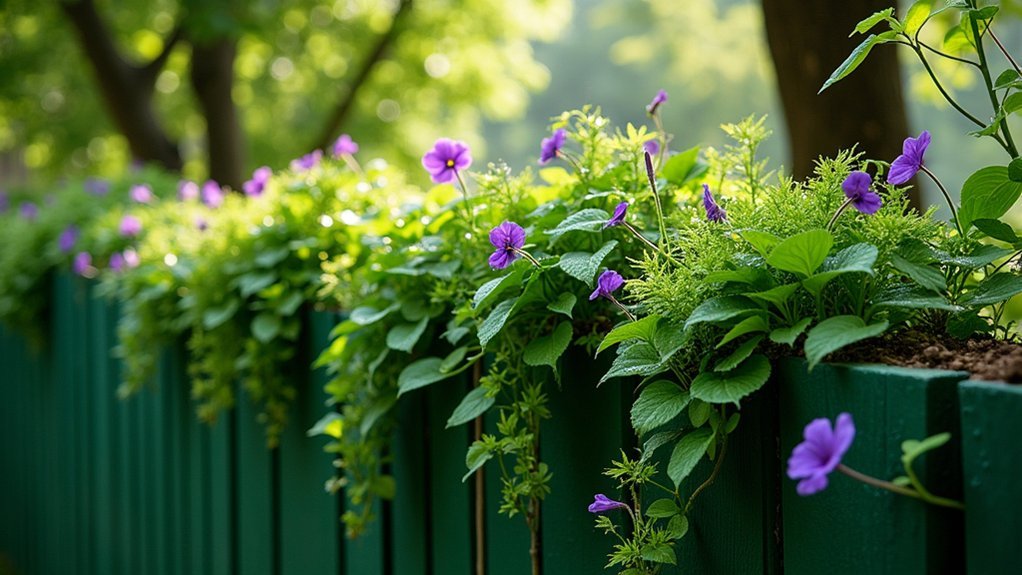



Leave a Reply